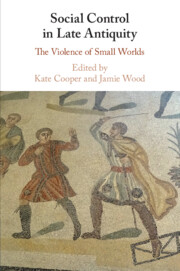Book contents
- Social Control in Late Antiquity
- Social Control in Late Antiquity
- Copyright page
- Contents
- Contributors
- Preface and Acknowledgements
- Abbreviations
- Introduction
- Part I Women and Children First
- Part II ‘Slaves, be subject to your masters’
- Chapter 5 Modelling Msarrqūtā
- Chapter 6 Constructing Complexity
- Chapter 7 Disciplining the Slaves of God
- Part III Knowledge, Power, and Symbolic Violence
- Part IV Vulnerability and Power
- Bibliography
- Index
Chapter 7 - Disciplining the Slaves of God
Monastic Children in Egypt at the End of Antiquity
from Part II - ‘Slaves, be subject to your masters’
Published online by Cambridge University Press: 18 September 2020
- Social Control in Late Antiquity
- Social Control in Late Antiquity
- Copyright page
- Contents
- Contributors
- Preface and Acknowledgements
- Abbreviations
- Introduction
- Part I Women and Children First
- Part II ‘Slaves, be subject to your masters’
- Chapter 5 Modelling Msarrqūtā
- Chapter 6 Constructing Complexity
- Chapter 7 Disciplining the Slaves of God
- Part III Knowledge, Power, and Symbolic Violence
- Part IV Vulnerability and Power
- Bibliography
- Index
Summary
The chapter analyses the presence of children in Byzantine Egyptian monasteries. It attempts to reconcile the seeming tension between the constant prohibition of and evidence for the ongoing presence of children in monasteries for an extended period. Ancient monastic and canonical norms provide vital information on this topic: most of them forbade any children in monasteries, even for a short period (e.g. to attend liturgies). However, some monastic sources confirm the presence of children in Byzantine-era Egyptian monasteries due to a variety of different circumstances, These varied from temporary to permanent residence, from children brought for education to those who were abandoned, traded, or donated to monasteries (because of social and economic hardships or medical conditions). For children facing such difficulties, the monastery was an opportunity to improve their quality of life, but, unfortunately, the monastic residence often became a place of violence and insecurity. Monastic obedience and submission to authority, alongside bodily punishments, were often and excessively applied in their education and formation as subjects of the monastic community and as future monastic members.
Keywords
- Type
- Chapter
- Information
- Social Control in Late AntiquityThe Violence of Small Worlds, pp. 151 - 170Publisher: Cambridge University PressPrint publication year: 2020
- 1
- Cited by

